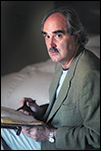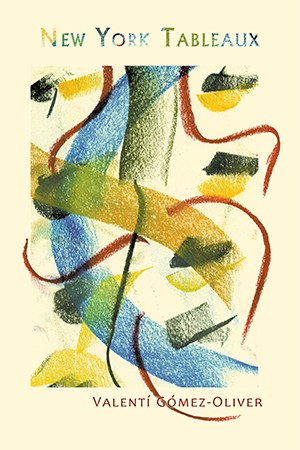Page last updated: August 3, 2021
All pages copyright © 2021 by Pinyon Publishing

NEW YORK TABLEAUX
Poetry and Art By Valentí Gómez-Oliver
Translated from the Catalan by Keith & Amanda Adams
Poems and refrains punctuated along a moving sidewalk space-time mural of New York City: the good, ugly, tender, and hard. Rhythmic clamor and musical riffs embedded in the strokes and colors of the accompanying artwork. The engaging English translation complete with rhyme and alliteration, inherent and essential to the poems. With a downbeat of “Earthy sewer fumes” the dance begins, to lace together earth and sky, solid and vapor. Enter the metro of mysticisms, opening to tender human truths. Writers and musicians; dreams and imagination; memory and forgetting; a collective creative force harnesses survival.
“A beautiful book of nine poems by nine illustrations—in fact eighteen, the illustrations are diptychs, an exercise in variations, of what Leibniz calls identitas in varietate. To the formal fluctuation is added the chromatic, and the drift could be seasonal, I would say from spring to autumn. The tableaux is made of an odd number of pieces, with centrality and symmetries. Tableaux as a mnemonic locus, as a figure of the world.
“Valentí Gómez i Oliver is a great connoisseur of the history of thought and spirituality and is also very fond of the traditional arts of strategy and its iconographic tricks. An altarpiece “tableaux”—an interior façade in the form of a compartmentalized cove, where various figures are placed around the main one. The wise old fox Valentí has placed his pieces with devilish skill, and even with some foul mood. The inadvertent reader can be confused by the apparent heterogeneity of the elements, ranging from classical antiquity to the heroes of the pulp and today. As in a carnival, they parade through the text: Pound, Guggenheim, Crane, Lorca, Warhol, Madoff, Obama; but also Poe, Freud, Pavese, Gilgamesh. In this fascinating poetic text the characters are drawn from Hellenic and Christian orthodoxy, and also from art and thought in general, from the Gnostics, the Cabal, Esotericism, Freemasonry.”
—Miquel de Palol, excerpts from a review in the Catalan paper, El Punt, and from a presentation at Blanquerna, Catalan Cultural Center in Madrid
“Because Saint George summons beauty and this is a book to give away. Because New York, sung by Walt Whitman and Federico García Lorca, has now been so in prodigious Catalan and with the tones and rhythms of the drawings of a poet to whom a black woman with hands shattered by life asked for the pen in the subway and after caressing her he returned to her with a God bless you, sir!, such a Madonna of the Tableaux of that city and of this astonishing and inexhaustible book.”
—Lluis Boada, economist and writer
“Lively, energetic, and delivered in many forms which aptly suit the polymorphous cacophony that is New York. Also the exuberant colors and lines of the drawings fly off the page like musical notes that don't want to be contained. The indefatigable poetry is also interspersed with the prose encounters (like "the pen", and "Lucinda Leonor") which ground the book, and provide human particular moments which I doubt the reader will forget. What I find pleasurably unusual is how readable the book is. Often long books of poems can exhaust, but you can take this in one gulp, because, among many other reasons, since it is filled with such a trove of history, literature, maxims, hermetic wisdoms, you learn something along the way.”
—Steve Clark, New York poet and film director
 Born in Barcelona, Spain, in 1947, VALENTÍ GÓMEZ-OLIVER studied at the Lycée Français, graduating in Philosophy and Humanities (Universitat de Barcelona). He also studied cinema and television in the Centro Sperimentale di Cinematografia (Experimental Center of Cinematography) with Roberto Rossellini.
Born in Barcelona, Spain, in 1947, VALENTÍ GÓMEZ-OLIVER studied at the Lycée Français, graduating in Philosophy and Humanities (Universitat de Barcelona). He also studied cinema and television in the Centro Sperimentale di Cinematografia (Experimental Center of Cinematography) with Roberto Rossellini.